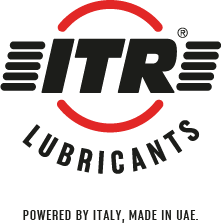ITR POWER TRANS oil is formulated for heavy construction machinery. The fluid has superior friction control and protects your transmission and hydraulic systems against wear and oxidation.
The transmission fluid lubricates brakes, clutches, final drive gears, torque converters, and the hydraulic system. The reliable friction control in the oil prevents clutch slippage and eliminates brake noise.
Characteristics Comparison Between ITR Trans Power Oils SAE10W and SAE30
| Typical Characteristics | ITR Trans PowerOil SAE10W | ITR Trans Power Oil SAE30 |
| Kinematic Viscosity @ 40°C(ASTM D 445): | 35.0-45.0 | 95-105 |
| Kinematic Viscosity @100 °C(ASTM D 445): | 6.0-7.0 | 11.0-12.0 |
| Viscosity Index (ASTM D 2270): | 110 min | 100 Min |
| Pour point (ASTM D 97): <-33 | <-33 | <-18 |
| Flashpoint (ASTM D 92 & 93) | >210 | >230 |
ITR POWER TRANS is an ISO-certified power and hydraulic transmission oil formulated for heavy construction machinery. The oils have reliable friction control.
To purchase our high-performance lubricant, please get a quote from ITR Lubricants.
How is Power Transmission Done?
A vehicle’s power transmission is a complex process consisting of the gearbox, clutch, propeller shaft, final drive, and differential unit.
Below are the steps for engine power transmission;
Step 1. From the engine to the gearbox through the clutch
The internal combustion engine gets the power to rotate the crankshaft from fuel combustion. The clutch connects the engine output shaft to the transmission gearbox input shaft.
The clutch is then automatically or manually operated to engage or disengage the engine and gearbox shaft in running condition. Power is transmitted from the engine shaft to the gearbox input shaft when the clutch is engaged.
Step 2. Gearbox to final drive via the propeller shaft
The gearbox converts a single rotation and speed of the engine into multiple levels of different torques and speeds. The gearbox output shaft is then connected to the propeller shaft.
The propeller shaft is connected to the final drive. Power is transmitted from the gearbox to the propeller shaft and then transferred to the final drive.
Step 3: Final drive, then differential unit to wheels via rear axles
The differential unit and final drive split the power from the propeller shaft to both side half axles where the wheels are mounted.
The power is then transmitted from the final driver to the rear axles and from the rear axles to the vehicle’s wheels.
FAQs
What is the SAE grading of lubricants?
SAE acronym means Society of Automotive Engineers) grading of Lubricants. It is a US-based body that regulates and grades lubricants based on the viscosity parameter.
What is a lubricant?
A lubricant is a substance applied between two objects that revolve/move in tandem with respect to each other. The fluid controls the friction between the moving surfaces, reducing the two objects’ tear and wear. Lubricants also clean, cool and protect the surfaces from oxidation and corrosion.
How is a lubricant made?
A lubricant is made from specially selected additives mixed and blended. The blended product is then subjected to quality control before packaging and distribution in the market.
How do I select the suitable lubricant for my motor vehicle?
Always consult the owner’s manual for your vehicle for oil requirements and specifications. You should confirm oil labels match the oil instructions before fueling.
